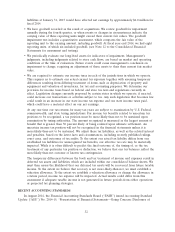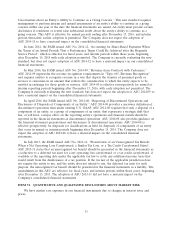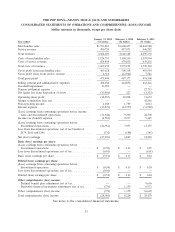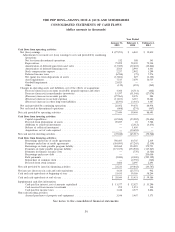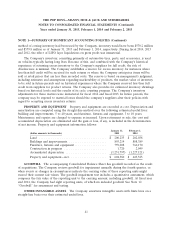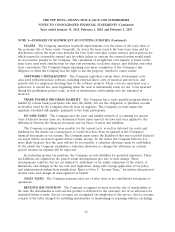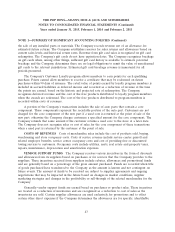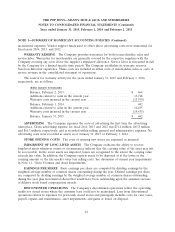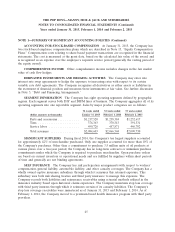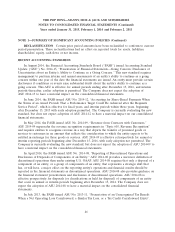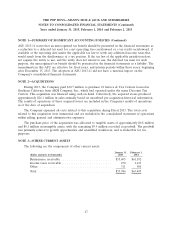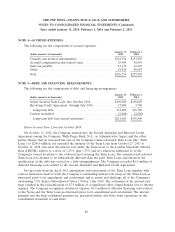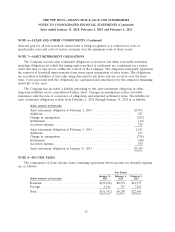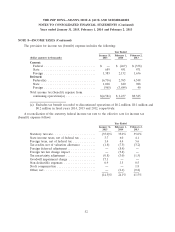Pep Boys 2014 Annual Report Download - page 48
Download and view the complete annual report
Please find page 48 of the 2014 Pep Boys annual report below. You can navigate through the pages in the report by either clicking on the pages listed below, or by using the keyword search tool below to find specific information within the annual report.THE PEP BOYS—MANNY, MOE & JACK AND SUBSIDIARIES
NOTES TO CONSOLIDATED FINANCIAL STATEMENTS (Continued)
Years ended January 31, 2015, February 1, 2014 and February 2, 2013
NOTE 1—SUMMARY OF SIGNIFICANT ACCOUNTING POLICIES (Continued)
LEASES The Company amortizes leasehold improvements over the lesser of the lease term or
the economic life of those assets. Generally, for stores the lease term is the base lease term and for
distribution centers the lease term includes the base lease term plus certain renewal option periods for
which renewal is reasonably assured and for which failure to exercise the renewal option would result
in an economic penalty to the Company. The calculation of straight-line rent expense is based on the
same lease term with consideration for step rent provisions, escalation clauses, rent holidays and other
lease concessions. The Company begins expensing rent upon completion of the Company’s due
diligence or when the Company has the right to use the property, whichever comes earlier.
SOFTWARE CAPITALIZATION The Company capitalizes certain direct development costs
associated with internal-use software, including external direct costs of material and services, and
payroll costs for employees devoting time to the software projects. These costs are amortized over a
period not to exceed five years beginning when the asset is substantially ready for use. Costs incurred
during the preliminary project stage, as well as maintenance and training costs are expensed as
incurred.
TRADE PAYABLE PROGRAM LIABILITY The Company has a trade payable program which is
funded by various bank participants who have the ability, but not the obligation, to purchase account
receivables owed by the Company directly from its suppliers. The Company, in turn, makes the
regularly scheduled full supplier payments to the bank participants.
INCOME TAXES The Company uses the asset and liability method of accounting for income
taxes. Deferred income taxes are determined based upon enacted tax laws and rates applied to the
differences between the financial statement and tax bases of assets and liabilities.
The Company recognizes taxes payable for the current year, as well as deferred tax assets and
liabilities for the future tax consequences of events that have been recognized in the Company’s
financial statements or tax returns. The Company must assess the likelihood that any recorded deferred
tax assets will be recovered against future taxable income. To the extent the Company believes it is
more likely than not that the asset will not be recoverable, a valuation allowance must be established.
To the extent the Company establishes a valuation allowance or changes the allowance in a future
period, income tax expense will be impacted.
In evaluating income tax positions, the Company records liabilities for potential exposures. These
tax liabilities are adjusted in the period actual developments give rise to such change. Those
developments could be, but are not limited to, settlement of tax audits, expiration of the statute of
limitations, and changes in the tax code and regulations, along with varying application of tax policy
and administration within those jurisdictions. Refer to Note 8, ‘‘Income Taxes,’’ for further discussion of
income taxes and changes in unrecognized tax benefit.
SALES TAXES The Company presents sales net of sales taxes in its consolidated statements of
operations.
REVENUE RECOGNITION The Company recognizes revenue from the sale of merchandise at
the time the merchandise is sold and the product is delivered to the customer, net of an allowance for
estimated future returns. Service revenues are recognized on completion of the service. Service revenue
consists of the labor charged for installing merchandise or maintaining or repairing vehicles, excluding
42


